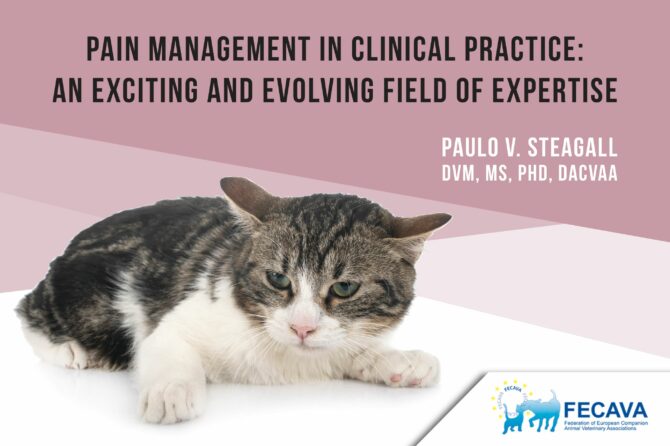
Pain management in clinical practice: an exciting and evolving field of expertise
The big picture
Pain management is far beyond giving a dose of drug A or B. It plays a huge role in animal welfare. Pain relief is part of a big picture that also includes minimizing stress, fear and anxiety in the hospital setting. This is usually accomplished with a fear-free approach, cat-friendly handling and nursing care techniques, etc. It involves the use of pharmacological but also non-pharmacological approaches. In humans, appropriate treatment of pain is associated with early recovery after surgery and shorter hospital stays. In animals with chronic conditions, pain management may reestablish the human-pet bond and improve the animals’ quality of life, mobility and sleeping disorders.
Attitudes and perception about pain and the issue of drug unavailability
Recent studies have shown that attitudes and perceptions of veterinarians towards the canine and feline pain management have improved but there is still a long way to go. For example, some veterinarians do not administer or prescribe analgesics when patients are discharged from the hospital (i.e. outpatients)*. In many countries, analgesia is suboptimal and analgesic availability is a major issue particularly with opioid analgesics. The inability of treating pain leads to animal suffering and contributes to the veterinarians’ compassion fatigue. The new World Small Animal Veterinary Association (WSAVA) list of essential medicines is an important milestone to support drug availability in veterinary medicine. It supports previous campaigns supported by FECAVA related to availability and accessibility and supports further campaigns within this context.
Recent advances in pain assessment
Veterinarians should consistently incorporate pain assessment in the physical examination as the 4th vital sign after temperature, pulse and rate (TPR). The advent of novel pain scoring systems/instruments should be incorporated into the veterinarians’ “toolbox”. These tools provide an objective approach for pain assessment and a guide to therapy. For example, acute pain scoring systems have a “cut-off” indicating if rescue analgesia should be administered for pain relief. The WSAVA Global Pain Council published guidelines on the assessment and treatment of pain in small animals. Its website has several resources and a list of pain assessment tools.
The Feline Grimace Scale was recently published by researchers at the Université de Montréal. The instrument is a simple, rapid, valid and reliable tool for acute pain assessment in cats. The article is open-access and veterinarians can download a training manual to be printed, laminated and used in the clinical setting. A video and a fact sheet document are also available for dissemination.
Other perspectives
Pain management is part of client communication. Owners want more information if their pets are suffering, like ways of managing the pain, expectations on short and long-term prognosis, potential drug-induced adverse effects, etc.** Veterinarians are now required to be prepared for a species-specific approach in clinical practice. For instance, dosage regimens are no longer extrapolated between dogs and cats. Pain-induced behavioral changes are different depending on the animal species and painful condition.
Additional resources
• Watch some simple, loco-regional anesthetic techniques
Local anesthetic blocks are a great means of providing acute perioperative pain relief. They are simple and cost-effective techniques but still underutilized. We published a series of local anesthetic techniques on YouTube that can be readily applicable in the clinical setting. For example, they show how to perform the intraperitoneal, incisional and intratesticular anesthetic blocks that can be used in spay-neuter programs (YouTube channel of the FMV UdeM – videos at the bottom):
Incisional and Intraperitoneal Anesthesia
Intercostal Block
Intratesticular Anesthesia
Intravenous Regional Anesthesia
Mandibular Nerve Block
Maxillary Nerve Block
Mental Nerve Block
Palatine Nerve Block
Infraorbital Nerve Block
Femoral nerve block
Sciatic Nerve Block
Epidural anesthesia
• Read the WSAVA-GPC capsule reviews in 14 different languages
These are open-access, peer-reviewed articles that present an evidence-based approach with practical recommendations on important and often controversial subjects in pain management. The first capsule reviews can be found here and here – Stay tuned for the upcoming articles!
And you?
How do you feel about your pain management skills? Would you want to pursue further training in pain management? It is a challenging but motivating and rewarding field of expertise. As an anaesthesiologist, I feel that I can make a difference for the patients that I have the chance to meet and treat. I invite you to attend lectures and workshops during your next continuing education event and read more about pain management in animals. It has never been a dull moment when you are learning about how you can make a huge difference!
Paulo V Steagall, DVM, MS, PhD, DACVAA
Université de Montréal
WSAVA Global Pain Council, WSAVA Dental Guidelines Committee, WSAVA Therapeutic Guidelines group
*Simon BT, Scallan EM, Carroll G, et al. The lack of analgesic use (oligoanalgesia) in small animal practice. J Small Anim Pract. 2017;58(10):543-554. doi:10.1111/jsap.12717
**Steagall P V., Monteiro BP, Ruel HLM, et al. Perceptions and opinions of Canadian pet owners about anaesthesia, pain and surgery in small animals. J Small Anim Pract. 2017;58(7):380-388. doi:10.1111/jsap.12674
Leave a reply

Leave a reply